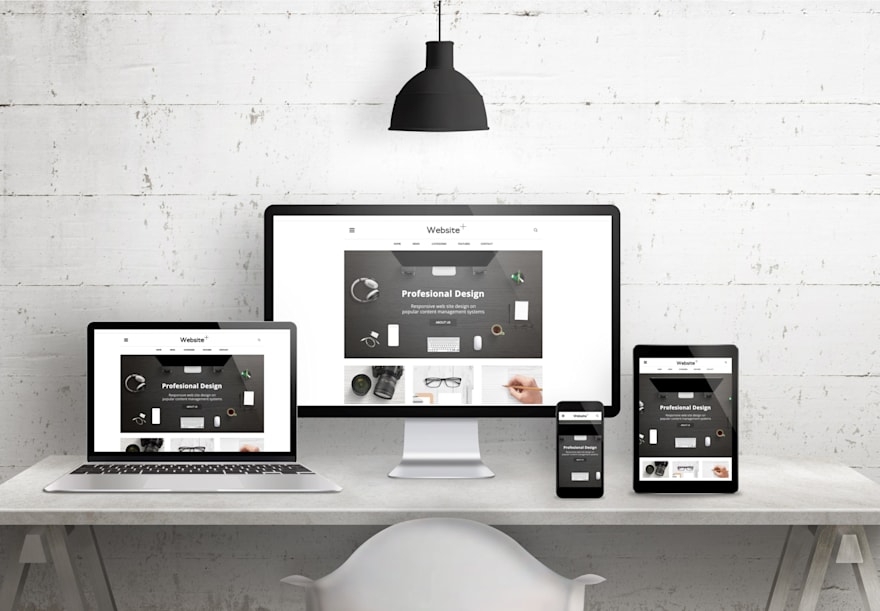What is a landing page?
A beginner's guide to learn all about what a landing page is
 December 3, 2020
December 3, 2020 8 minute reading
8 minute reading
We all know the importance of a website for establishing your brand’s online presence, but what if you want to take your business further and boost your conversions, leads, and sales? This is where a landing page comes in handy, but still for some business owners landing pages are somehow difficult to understand, especially when it comes down to why, when, and how to use them.
Thankfully, help is at hand, by the end of this guide you'll learn everything you need to know about what a landing page is, how do they differ from other pages within your website, and above all why and when you should use them.
Let's start
1.What is a landing page?
A landing page is an individual web page created with the goal of advertising or marketing a specific product or service. It is where a potential customer “lands” after they click a link that generally marketers place within an email, or a paid search text ad from a search engine like Google, or any other place on the web.
2. What’s the difference between a landing page and a web page?
We might call a landing page a type of web page, but it’s important to note that it still differs from a typical web page. A web page will contain multiple links and numerous goals for its visitor, such as encouraging them to read additional articles, learn more about the author, or follow the brand on social media, for example.
A landing page, on the other hand, is easily distinguishable as it is designed with just one goal in mind: its single call-to-action. It will feature no website navigation, thus reducing potential distractions, and encourage visitors to perform that one single goal, rather than click away.
3. What’s the difference between a landing page and a homepage?
Let’s look at the ways in which a landing page differs from a home page. While a landing page is designed with one specific goal in mind (encouraging a conversion to take place), a home page is designed for exploration, encouraging the viewer to look around, click more links, and stay awhile.
In other words, a home page will encompass everything a brand has to offer. They provide shorter snippets of information about various topics, all with the purpose of providing a general overview of the business that viewers can click-through to multiple web pages to learn more about.
4. What’s the difference between a landing page and a sales page?
By now, you might be thinking: If a landing page can have such a strong focus on encouraging a sale, isn’t it just the same thing as a sales page?
The short answer is: All sales pages are landing pages, but not all landing pages are sales pages. Let’s break that down so it makes more sense.
Sales pages are simply transactional pages, as their number-one goal is to encourage the visitor to make a purchase.
Not all landing pages are created with the option for the visitor to make a purchase, however. Some may include an opt-in freebie such as an ebook in exchange for the visitor’s personal details, so they can be added to a company’s marketing funnel. Other examples of landing pages that aren’t sales pages are those designed to host a giveaway or advertise a free community event.
5. Why should you use landing pages?
Landing pages are the most efficient way to convert visitors into customers or leads. Point.
But what is it that makes landing pages so effective for marketing than web pages?
Really, it all comes down to two elements: attention ratio and message match.
Attention Ratio refers to the number of potential actions your visitor can take on a single web page (i.e. links to click) versus the action(s) you actually want them to take to convert.
Realistically, a home page could have an attention ratio of 20:1, as there are 20 other options for them to click-through to, rather than that single ‘Sign Up’ or ‘Buy Now’ button.
A landing page, on the other hand, aims for an attention ratio of just 1:1. There is only one action for the visitor to take, in the form of a call-to-action, which also matches the single intended goal.
Ultimately, the fewer distractions a viewer has, the higher the conversion rate will be for that page.
Message Match refers to your page’s capacity to accurately portray the advertising copy that influenced the visitor to click-through to your page in the first place. Your advertising copy would have set a specific expectation for what the viewer would gain from visiting your landing page (whether it’s a free download, bonus gift with a purchase, or reduction in the price of a product), and you certainly don’t want to disappoint.
This is why it's a lot more effective at achieving a high message match than a home page, for example. Since a landing page is structured around a singular goal, the desired action is clearly evident to the visitor. With a home page’s usual mishmash of content, what was initially promised to the visitor may be harder to find.
Now that you understand the two main reasons why you should use a landing page, as opposed to a regular web page, to achieve conversions, let’s take a look at the specific situations when you should a landing page.
6. When should you use landing pages?
Here are three situations when landing pages would be ideal:
Segmented promotional offers. If you’re running different promotions aimed at different segments of your customers, then separate landing pages for these deals are necessary. For example, you might have varying offers for new customers, those who have signed up for a free trial, or customers who are part of your high-tier plan. Creating separate pages for your separate promotions allows you to easily adjust the campaign’s call-to-action, copy, and design to match its intended audience.
Multiple products. When you’ve got multiple distinct types of items for sale, or even a single product or service that has different attributes associated with it, then these might be better represented across multiple landing pages. This allows you to create separate pages dealing with the different contexts and target audiences, therefore aiming to increase your conversions.
Multiple traffic sources. When you run an advertising or marketing campaign across multiple channels, such as email, various social media platforms, and more, they can also benefit from separate landing pages for each traffic source. Why? Because each of your channels may be home to a different type of audience, so you’ll want to promote different messaging, imagery, or call-to-actions to match.
7. Landing pages best practices
Because landing pages are designed around a single goal or action, they can be mistaken as something that is quick and easy to create. Of course, once you get the hang of creating these pages, they do become like second nature, but there are some vital things to keep in mind when doing so.
Ensure your landing page content matches its ad copy. We talked about message matches earlier in this guide, but it really is a vital component of a successful landing page. Match your content, including copy, design, and desired action, to the ads you’re running across your social channels or in search engines. If you promise your visitor one thing and don’t deliver, they’ll be closing your page within seconds.
Place what’s most important above the fold. Above the fold of a web page refers to the part of the page a visitor can see before they need to scroll. This is prime real estate on a landing page and is the place where you need to put the most important elements for increasing conversion: the headline, hero image, unique sales proposition, and call-to-action. Everything else can be placed underneath this.
Use visual cues to keep visitors scrolling. Once you’ve got the viewer’s attention above the fold, it’s time to encourage them to keep scrolling and reading your landing page’s content through visual cues, such as arrows, animations, illustrations, or even additional, large headings. Directional cues such as bold, colorful, and/or 3D-effect call-to-action buttons should also be used so they stand out from the rest of the content.
Show your offering in a real-life context. Allow viewers to imagine themselves as the customer by showcasing imagery featuring your product or service being used by a real person in real-time. By placing an image such as this as your page’s hero image (the large image above the fold), you’ll quickly and easily capture their attention.
Remove distractions such as navigation. Remember how a landing page is so effective due to its lack of distractions, such as page navigation and other links? Ensure your page doesn’t contain anything that doesn’t directly contribute to the main action you want your visitor to take.
Showcase authentic social proof. Back up your claims of how wonderful your product or service is by including authentic social proof from previous customers on your landing page. Whether it’s a short testimonial or review, or even a lengthy video discussing their experience with your offering, this social proof goes a long way in convincing your viewers that your marketing message is the real deal. Try to include the customer’s portrait, full name, general location, and/or date of purchase (with their permission, of course), to prove their authenticity.
Captivate with clear and compelling copy. When it comes to the copy of your landing page, the saying “short and sweet” rings true. Keep your content clear and to-the-point while still effectively conveying the necessary information to help your visitor convert. Think shorter sentences, bulleted lists, and very few (if any) chunky paragraphs.
Ensure a fast loading time. Did you know that 40% of people abandon a web page that takes more than 3 seconds to load? That’s a lot of potential customers! Avoid slow loading landing pages by only including what’s necessary and ensuring your uploaded images have been compressed. A great resource to help you determine if your page has an optimal loading time is Google’s PageSpeed Insights (PSI) tool.
Optimize it for the right device. When you create your landing page, it’s best practice to optimize it for both web and mobile if the campaign will be targeting audiences who use both applications. This is because, while a visitor may have the capability to browse the web-optimized page on their mobile, it will visually look different (as the screen is smaller), have limited interactivity, and potentially load much slower. You can use a template or design software that allows you to create a landing page that is both web and mobile-responsive, so it can easily adapt to the different viewing platforms, however utilizing the help of professional web designers might make this process a whole lot easier on you.
Utilize the help of professionals and resources. Take advantage of professionals within this field — especially if you don’t have much interest or prior experience in creating highly-converting landing pages. It truly is an art. There are talented freelancers that specialize in wireframe & UX design services including landing page copywriting and optimization who can prove to be extremely helpful.
Bottom line: landing pages are an indispensable part of marketing
According to Hubspot, companies that increase their number of landing pages from 10 to 15 see a 55% increase in leads. But that's not all. Effective landing pages do much more than generate leads and conversions, they help build credibility, drive more search traffic, provide value to the readers, and improve your website click-through rates.
Yes indeed, landing pages are a very important aspect of your digital marketing campaign, and the more you create the better it is. If you still don't use them because you simply don't know how to set them up, don't get left behind, hire a landing page specialist today to help you quickly create and set up as many landing pages as you can in no time.


![Lead generation [a beginner's guide] lead generation](https://fiverr-res.cloudinary.com/image/upload/w_700/f_auto,q_auto/v1/attachments/generic_asset/asset/b7b455eb620128730e18b280ee5c346c-1606404112966/Lead%20generation-min.jpg)